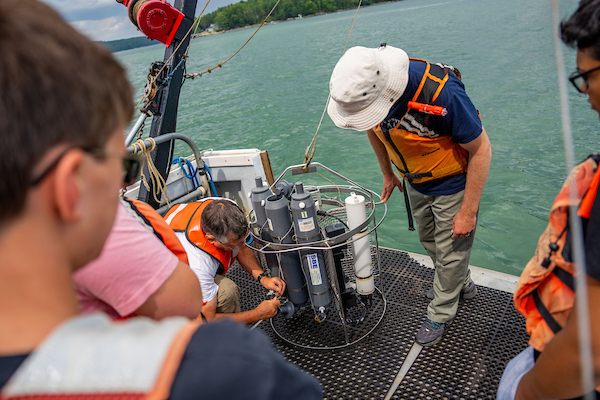Research
The outer limits of SMS research shift frequently based on research results and new research approaches both at SMS and in other marine institutions worldwide. Collaborations also form and shift. At any one moment, an SMS investigator may be helping a terrestrial or freshwater researcher in Maine or Chile because of a recent advance in methodology. In the next month that flow of expertise might be reversed or moved to China. Where advances will take place is less predictable than that they will be exploited more broadly than one person could imagine. The best way to gain an appreciation for these outer limits is to visit individual SMS web pages.
Core research areas shift more slowly and central issues are therefore more easily plumbed. Marine biologists ask fundamental questions about how individual organisms and their physiologies and organ systems operate. Issues include sensory biology, reproduction, toxicity and basic ecology. Biological oceanographers put these organisms into the context of physical, chemical and geological processes. Physical, chemical and geological oceanographers develop understanding of processes that move mass and momentum and that transform its liquid, solid, granular and multiphasic forms and chemistries.

To give a few, non-exhaustive ideas of marine areas in which UMaine has particular concentrations of faculty, we describe some research clusters (please see the menu on the left).
A great benefit of working in a moderately sized or large marine program is that both principal investigators and students gain exponentially from strong interactions within clusters of faculty, postdocs, staff and students who have related research interests. At about 30 faculty, the School of Marine Sciences is one of the largest marine units in the country. Clusters provide ideal sources of graduate supervisory committees. The existence of a nucleus of faculty with overlapping research interests is in fact among the best criteria for choosing one graduate school over another. Furthermore, at the advanced graduate level, distinctions between research and teaching blur as students, postdocs, staff and faculty push the limits of existing knowledge. Many members of the clusters listed here co-teach courses that take advantage of their common interests. Although many pairs and larger groupings of faculty within clusters do actively collaborate, we do not wish to create the impression that all investigators within a cluster actively collaborate on specific projects at the present time. Two modes of cluster use by students complement one another. Students can fit into an existing cluster of collaborating faculty, adding faculty from other departments, or they can build new clusters in their supervisory committees. Marine sciences are highly interdisciplinary, and novel combinations in new directions often appear first in the form of Ph.D. projects that build between two formerly separate skills or fields. Visit the complete faculty list and make your own clusters.
